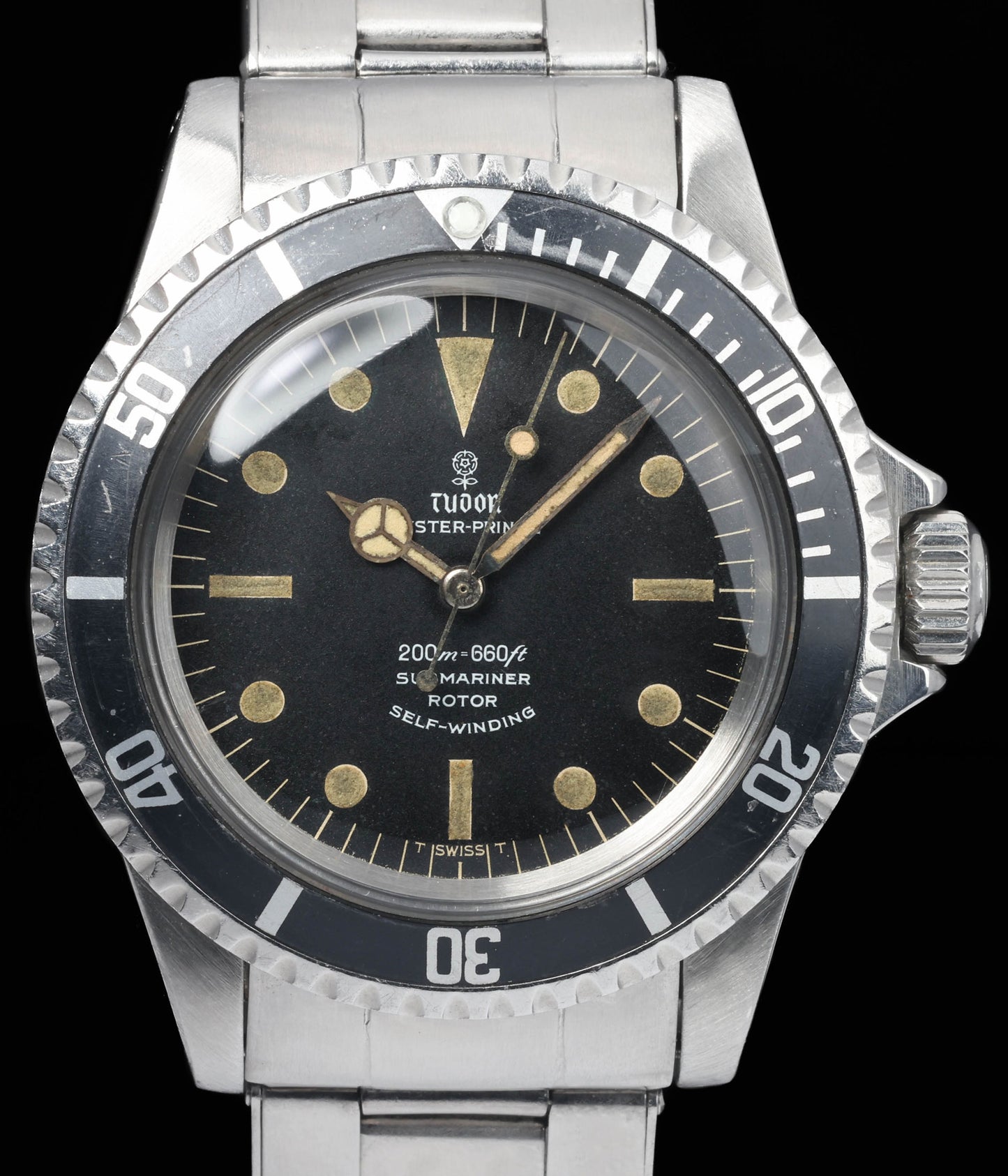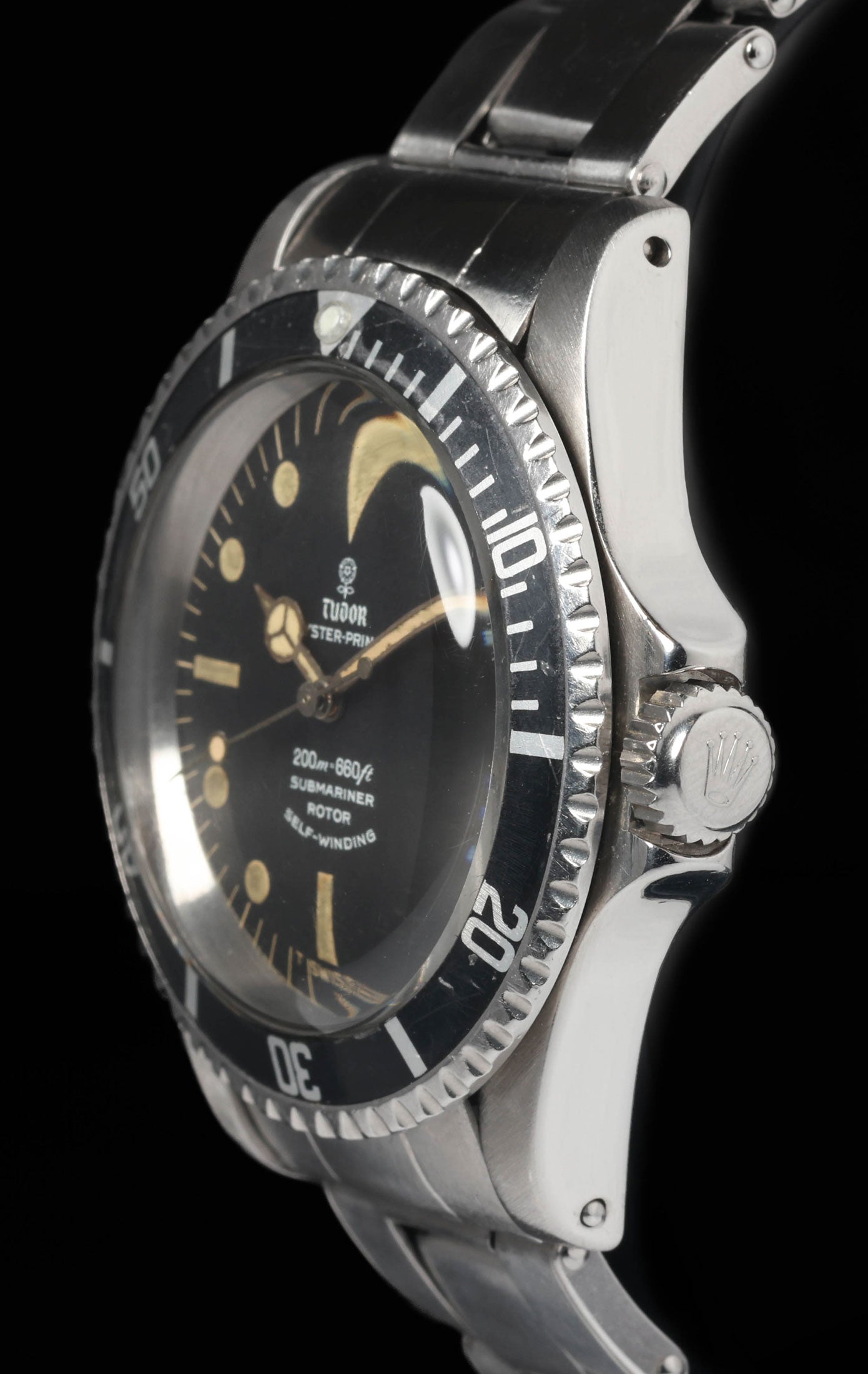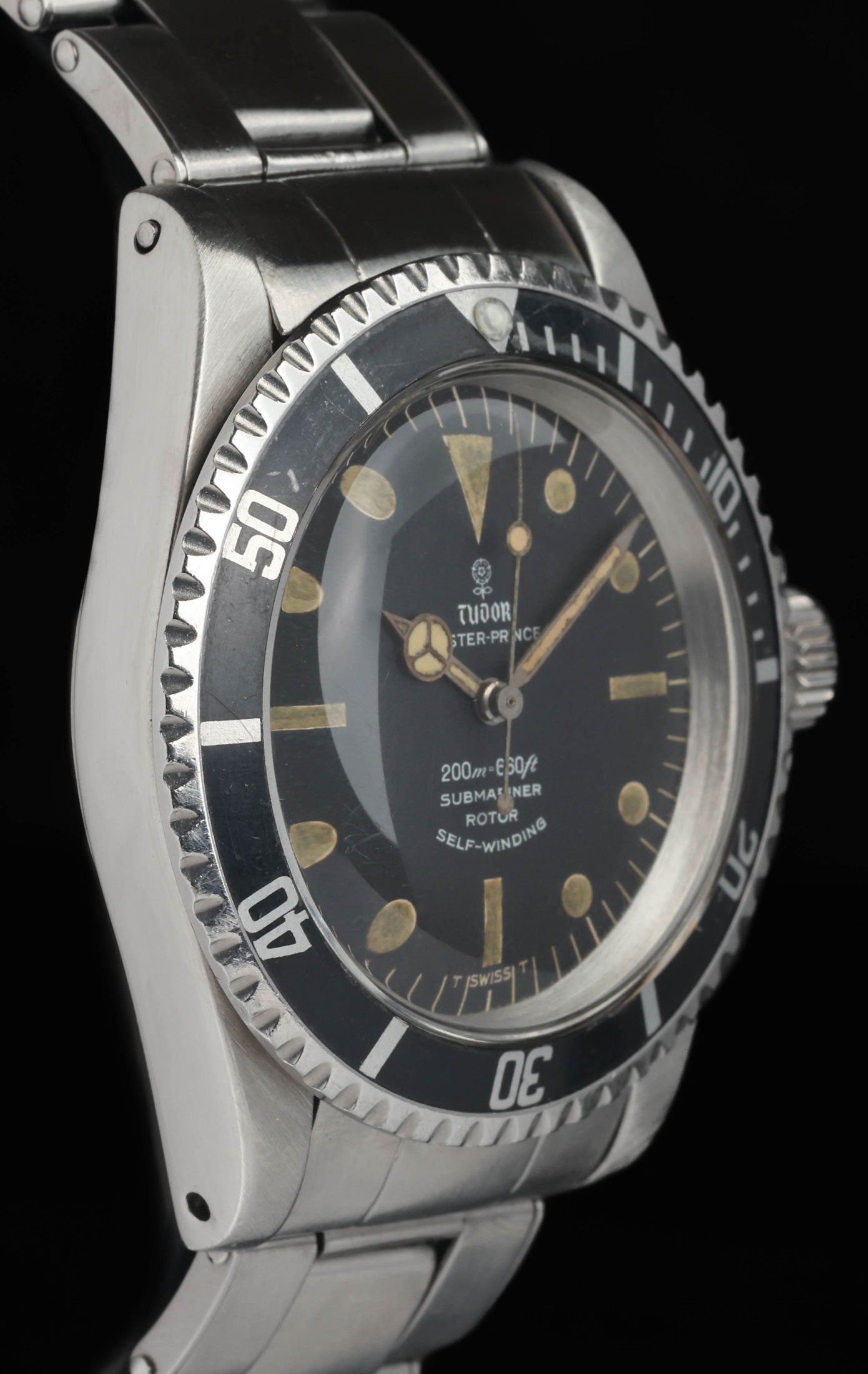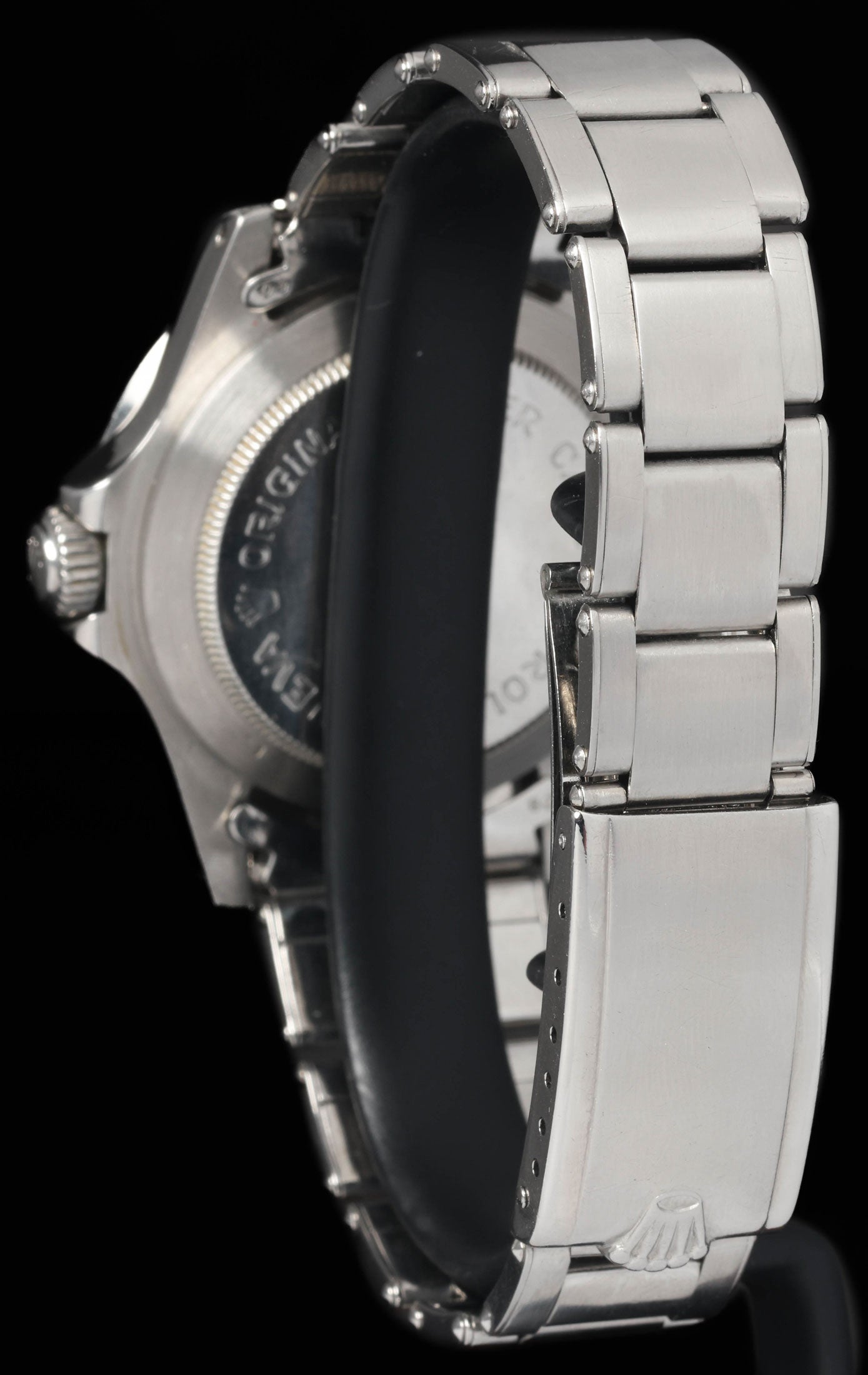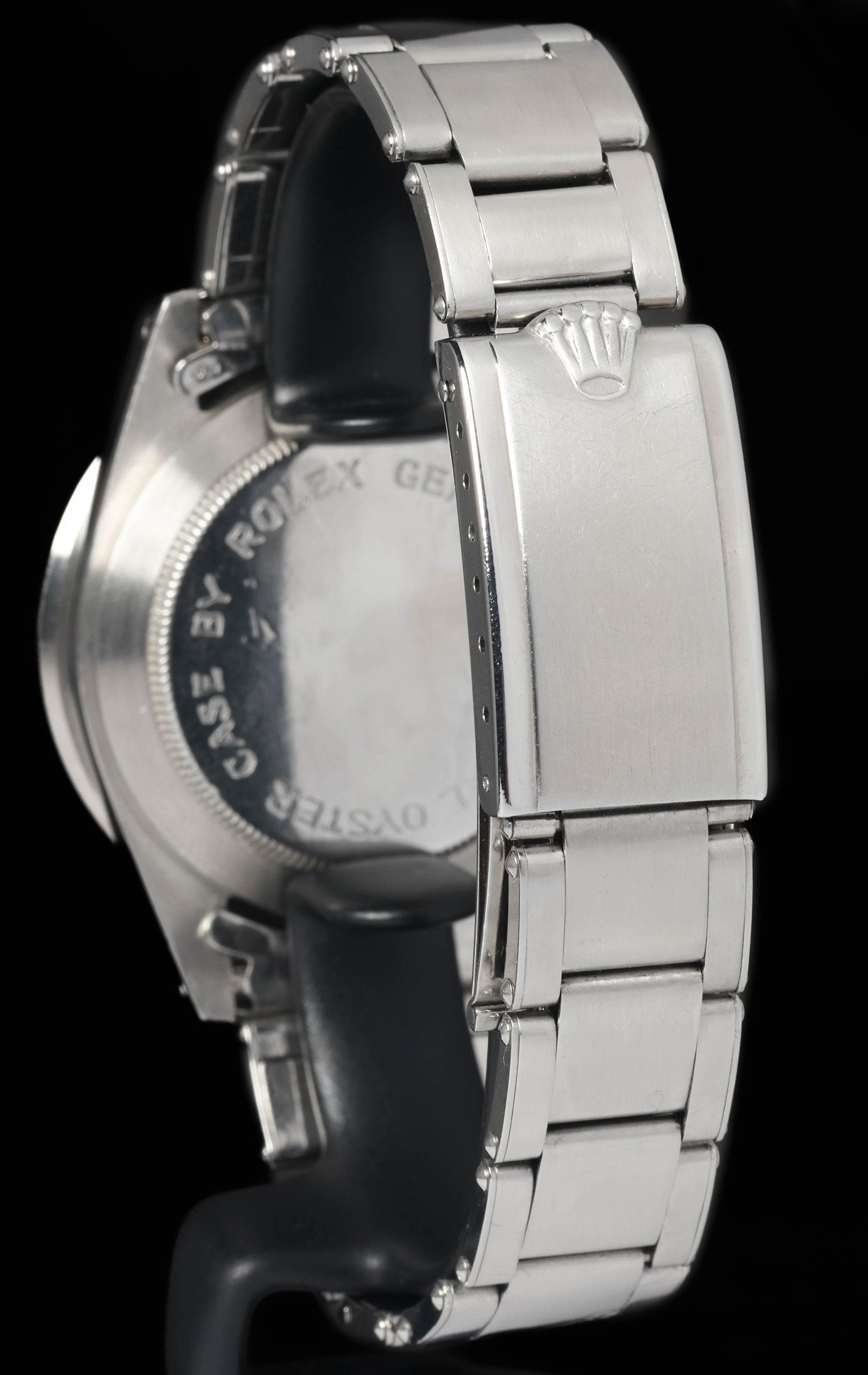Crown Vintage
Tudor Submariner Oyster-Prince 7928 40MM 1967
Tudor Submariner Oyster-Prince 7928 40MM 1967
Couldn't load pickup availability
Tudor Submariner Oyster-Prince 7928 40MM 1967
Case presents in excellent condition with sharp, even lugs and little to no wear visible. Factory brushing is still evident across the tops of the lugs and flanks, with crisp chamfers and no obvious dings. Bezel retains its period aluminium insert with clean numerals and only light surface wear; the lume pearl remains present. Acrylic crystal shows minor handling marks consistent with age but nothing that impairs legibility. Crown guards are well-defined and the Rolex-signed screw-down crown sits square.
Caseback edges appear sharp.7206 rivet Oyster bracelet is in great condition with tight links at the end pieces and some expected, even stretch through the run; folding clasp closes securely and shows honest desk wear only. End links fit flush to the case with no play.
Gilt dial is in good condition with intact chapter ring and crisp printing. Tritium hour plots have aged to an even, warm tone with no visible flaking or dark spotting. Minute track is complete and clean.
Gilt hands are in good condition with matching luminous tone and no corrosion observed to the pinion or hand centres. Lollipop seconds and Mercedes hour hand display consistent ageing with the dial.
Overall, a very well-preserved Tudor Submariner 7928 that remains cohesive across case, bezel, dial and bracelet. As this watch is well over 30 years old, it should be treated as a vintage timepiece and not worn while swimming, even though it was originally designed as a dive watch.
Share
Why we love this watch
Why we love this watch
Tudor Submariner 7928: A 1967 Icon of Diving Heritage
Introduction
The Tudor Submariner reference 7928 stands as one of the most important dive watches of the 1960s. Produced between the late 1950s and late 1960s, it represents the moment Tudor fully embraced its role as a serious tool watch manufacturer, closely tied to but distinct from Rolex. This 1967 example captures the essence of what made the 7928 such a defining model: robust case design, functional dial layout, and purposeful aesthetics that mirrored the professional diving needs of its time.
The Origins of the Tudor Submariner
When Tudor introduced its first Submariner in 1954, it quickly established itself as an accessible yet uncompromising alternative to the Rolex Submariner. Hans Wilsdorf, the founder of Rolex and Tudor, positioned the brand to use Rolex cases and crowns while relying on Swiss ébauche movements to keep prices competitive. This formula meant divers could rely on the same watertight Oyster case construction and screw-down crown found in Rolex Submariners, but at a lower cost.
By the late 1950s, Tudor had refined its dive watch program, culminating in the launch of the reference 7928. For the first time, the Tudor Submariner featured crown guards—an essential protective detail that mirrored the evolutionary changes occurring within Rolex’s own Submariner line. This marked the 7928 as the watch where Tudor truly came of age in the tool watch arena.
The 1967 Tudor Submariner 7928
The 1967 example sits within the later period of the 7928’s production, identifiable by its pointed crown guards, gilt printing on earlier dials evolving into white print, and matte dial designs with tritium lume plots that aged to a rich golden hue. The watch pictured carries these hallmarks: a matte black dial with creamy tritium plots, gilt hands showing the passage of time, and the bold Tudor rose emblem—used until Tudor transitioned to the shield logo in the late 1960s.
The dial layout is immediately legible. Oversized triangular, rectangular, and circular markers provide maximum visibility underwater, while the rotating bezel with 60-minute graduations enables divers to track elapsed time with ease. The “200m = 660ft” depth rating asserts its professional-grade credentials, aligning Tudor with the diving standards of the era.
Case Design and Evolution
The 39mm stainless steel Oyster case was manufactured by Rolex and shared the same fundamental architecture as its Submariner counterparts. Its pointed crown guards—often referred to as “PCGs”—define the 1967 iteration, adding symmetry and protection for the large Rolex-signed screw-down crown. The bezel, with its serrated edge for grip, retained the utilitarian look that professional divers required, with aluminium inserts that aged uniquely across individual watches.
Earlier 7928 examples displayed square crown guards, but by the mid-1960s these had evolved into the pointed style seen here. This gradual refinement reflects Tudor’s attention to user feedback from divers and military clients. The caseback engraving and bracelet pairing—often a riveted Oyster or folded link variant—tie this reference firmly into its Rolex lineage.
Tudor and Military Issuance
One of the most significant aspects of the 7928’s history is its use by various military forces, including the French Navy (Marine Nationale). These issued watches bore military engravings and were chosen for their ruggedness and cost-effectiveness compared to Rolex. While not every 7928 left the factory destined for military service, the reference’s connection to professional use further cements its place in diving history.
A civilian 1967 example such as this one carries the same DNA. Its robust construction, clear dial, and enduring reliability underline why it was favoured in professional environments. Even outside military use, many commercial and recreational divers relied on the 7928 through the 1960s.
Dial and Hands of the 1967 Example
The watch pictured displays a matte dial with luminous tritium plots that have developed a warm patina. Unlike glossy gilt dials of earlier years, the matte surface reduced glare and provided maximum legibility underwater. The gilt Mercedes-style hour hand and distinctive lollipop seconds hand are pure 1960s Tudor design, echoing the style cues of Rolex but with subtle differences in proportion and finish.
What makes this particular watch stand out is the natural uniformity of its aged lume. The markers and hands have developed the same golden hue, an aesthetic characteristic highly regarded in vintage watches today. The Tudor rose logo on the dial, positioned above the “Tudor Oyster Prince” designation, marks the end of an era before the transition to the Tudor shield.
Movement and Mechanics
Inside the 7928 beats an ETA-based automatic movement, chosen for its reliability and ease of service. Tudor’s decision to use ébauche calibres allowed the brand to maintain affordability while still offering robust performance. The movement is protected by the Rolex-manufactured screw-down caseback and twin-lock crown system, ensuring water resistance to 200 metres.
While Rolex movements carried their own prestige, Tudor’s use of ETA movements did not diminish the functionality of the watch. For divers of the 1960s, reliability and accuracy mattered far more than movement pedigree, and the 7928 delivered on both counts.
The Role of the 7928 in Tudor’s Legacy
The reference 7928 stands as the cornerstone of Tudor’s Submariner history. It cemented the brand’s reputation as a manufacturer of rugged professional watches and set the design codes that would define future Tudor dive watches for decades. Later models, including the 7016 and 9401, owe their DNA to the 7928’s combination of case architecture, dial readability, and water resistance.
The 1967 model represents the culmination of this reference before Tudor transitioned to new aesthetics in the late 1960s. It holds a unique place in Tudor history as one of the last Submariners to carry the rose emblem, connecting it back to Tudor’s earliest branding roots.
Historical Significance of the 1967 Tudor Submariner
The year 1967 was pivotal in the world of diving watches. Rolex was refining the Submariner 5513 and preparing for the Sea-Dweller, Omega was advancing its Seamaster 300 line, and Blancpain was developing further variations of the Fifty Fathoms. Against this backdrop, Tudor’s 7928 held its own as a serious professional instrument.
Its adoption by military units underlined its credibility, while its commercial availability allowed professional and amateur divers alike to access a high-quality dive watch. This dual role—accessible yet uncompromising—became the defining feature of Tudor throughout its history.
Final Thoughts
The Tudor Submariner 7928 from 1967 embodies everything that makes vintage dive watches compelling: robust construction, purposeful design, and historical importance. Its pointed crown guards, matte dial with warm patina, and Tudor rose emblem mark it as a transitional yet definitive piece within the Tudor Submariner story. More than just a watch, it represents an era when diving instruments were built for survival, not style. Today, the 7928 remains a cornerstone of Tudor’s history and a reminder of the brand’s deep connection to the golden age of tool watches.
Case & Bracelet
Case & Bracelet
- Case in excellent condition, little to no wear visible.
- Factory brushing is still visible.
- 7206 rivet bracelet in great condition, some stretch as expected with age.
Dial & Hands
Dial & Hands
- Gilt dial in good condition.
- Gilt hands in good condition.
Warranty & Condition
Warranty & Condition
Crown Vintage Watches provides a minimum 3-month mechanical warranty on pre-owned watches, from the date of purchase.
The warranty covers mechanical defects only.
The warranty does not cover damages such as scratches, finish, crystals, glass, straps (leather, fabric or rubber damage due to wear and tear), damage resulting from wear under conditions exceeding the watch manufacturer’s water resistance limitations, and damage due to physical and or accidental abuse.
Please note, water resistance is neither tested nor guaranteed.
Shipping and insurance costs for warranty returns to us must be covered by the customer. Returns must be shipped via traceable courier. Return shipment must be pre-paid and fully insured. Collect shipping will be refused. In case of loss or damages, the customer is liable.
Our Pledge
At Crown Vintage Watches, we stand by the authenticity of every product we sell. For added peace of mind, customers are welcome to have items independently authenticated at their own expense.
Condition
Due to the nature of vintage timepieces, all watches are sold as is. We will accurately describe the current condition and working order of all watches we sell to the best of our ability.
Shipping & Refund
Shipping & Refund
